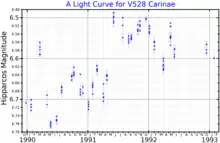V528 Carinae
V528 Carinae (V528 Car, HD 95950, HIP 54021) is a variable star in the constellation Carina.
| Observation data Epoch J2000 Equinox J2000 | |
|---|---|
| Constellation | Carina |
| Right ascension | 11h 03m 06.15s[1] |
| Declination | 60° 54′ 38.6″[1] |
| Apparent magnitude (V) | 6.27 - 6.78[2] |
| Characteristics | |
| Spectral type | M2 Ib:[3][4] |
| B−V color index | +2.04[5] |
| Variable type | Lc[6] |
| Astrometry | |
| Radial velocity (Rv) | −27.80[7] km/s |
| Proper motion (μ) | RA: –7.639[1] mas/yr Dec.: +2.109[1] mas/yr |
| Parallax (π) | 0.4504 ± 0.0293 mas[1] |
| Distance | 7,200 ± 500 ly (2,200 ± 100 pc) |
| Absolute magnitude (MV) | −6.09[5] |
| Details | |
| Radius | 415[8] R☉ |
| Luminosity | 26,000 - 28,000[8] L☉ |
| Surface gravity (log g) | 0.0[5] cgs |
| Temperature | 3,660±170[8] K |
| Other designations | |
| Database references | |
| SIMBAD | data |
V528 Carinae has an apparent visual magnitude that varies between about 6.3 and 6.8. It is a distant star but the exact distance is uncertain. The Hipparcos satellite gives a negative annual parallax and is not helpful,[9] while the Gaia Data Release 3 parallax of 0.45 mas implies a distance around 7,200 light years.[1] Assuming membership of the Carina OB2 membership would give a distance of about 1,830 parsecs.[10]

V528 Carinae is a red supergiant of spectral type M2 Ib with an effective temperature of 3,660 K. It has a radius of 415 solar radii. In the visible spectrum, its luminosity is 11,900 times higher than the sun, but the bolometric luminosity considering all wavelengths reaches around 30,000 L☉.[8] It loses mass at 0.5×10−9 M☉ per year.[12]
It is classified as a slow irregular variable whose prototype is TZ Cassiopeiae.[6]
See also
References
- Vallenari, A.; et al. (Gaia collaboration) (2023). "Gaia Data Release 3. Summary of the content and survey properties". Astronomy and Astrophysics. 674: A1. arXiv:2208.00211. Bibcode:2023A&A...674A...1G. doi:10.1051/0004-6361/202243940. S2CID 244398875. Gaia DR3 record for this source at VizieR.
- "V528 Car". International Variable Star Index. AAVSO. Retrieved 2022-11-25.
- Humphreys, Roberta M.; Strecker, Donald W.; Ney, E. P. (1972). "Spectroscopic and Photometric Observations of M Supergiants in Carina". Astrophysical Journal. 172: 75. Bibcode:1972ApJ...172...75H. doi:10.1086/151329.
- Malyuto, V.; Oestreicher, M. O.; Schmidt-Kaler, Th. (1997). "Quantitative spectral classification of galactic disc K-M stars from spectrophotometric measurements". Monthly Notices of the Royal Astronomical Society. 286 (2): 500. Bibcode:1997MNRAS.286..500M. doi:10.1093/mnras/286.2.500.
- Levesque, Emily M.; Massey, Philip; Olsen, K. A. G.; Plez, Bertrand; Josselin, Eric; Maeder, Andre; Meynet, Georges (August 2005). "The Effective Temperature Scale of Galactic Red Supergiants: Cool, but Not As Cool As We Thought". The Astrophysical Journal. 628 (2): 973–985. arXiv:astro-ph/0504337. Bibcode:2005ApJ...628..973L. doi:10.1086/430901. S2CID 15109583.
- Samus, N. N.; Durlevich, O. V.; et al. (2009). "VizieR Online Data Catalog: General Catalogue of Variable Stars (Samus+ 2007-2013)". VizieR On-line Data Catalog: B/GCVS. Originally Published in: 2009yCat....102025S. 1. Bibcode:2009yCat....102025S.
- Gontcharov, G. A. (2006). "Pulkovo Compilation of Radial Velocities for 35 495 Hipparcos stars in a common system". Astronomy Letters. 32 (11): 759–771. arXiv:1606.08053. Bibcode:2006AstL...32..759G. doi:10.1134/S1063773706110065. S2CID 119231169.
- Messineo, M.; Brown, A. G. A. (2019). "A Catalog of Known Galactic K-M Stars of Class I Candidate Red Supergiants in Gaia DR2". The Astronomical Journal. 158 (1): 20. arXiv:1905.03744. Bibcode:2019AJ....158...20M. doi:10.3847/1538-3881/ab1cbd. S2CID 148571616.
- Van Leeuwen, F. (2007). "Validation of the new Hipparcos reduction". Astronomy and Astrophysics. 474 (2): 653–664. arXiv:0708.1752. Bibcode:2007A&A...474..653V. doi:10.1051/0004-6361:20078357. S2CID 18759600.
- Melnik, A. M.; Dambis, A. K. (2020). "Distance scale for high-luminosity stars in OB associations and in field with Gaia DR2. Spurious systematic motions". Astrophysics and Space Science. 365 (7): 112. arXiv:2006.14649. Bibcode:2020Ap&SS.365..112M. doi:10.1007/s10509-020-03827-0. S2CID 220128144.
- "/ftp/cats/more/HIP/cdroms/cats". Centre de Données astronomiques de Strasbourg. Strasbourg astronomical Data Center. Retrieved 15 October 2022.
- Josselin, E.; Blommaert, J. A. D. L.; Groenewegen, M. A. T.; Omont, A.; Li, F. L. (2000). "Observational investigation of mass loss of M supergiants". Astronomy and Astrophysics. 357: 225. Bibcode:2000A&A...357..225J.